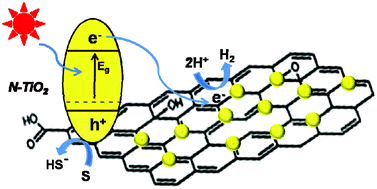In-situ preparation of N-TiO2/graphene nanocomposite and its enhanced photocatalytic hydrogen production by H2S splitting under solar light†
Abstract
Highly monodispersed nitrogen doped TiO2 nanoparticles were successfully deposited on graphene (N-TiO2/Gr) by a facile in-situ wet chemical method for the first time. N-TiO2/Gr has been further used for photocatalytic hydrogen production using a naturally occurring abundant source of energy i.e. solar light. The N-TiO2/Gr nanocomposite composition was optimized by varying the concentrations of dopant nitrogen and graphene (using various concentrations of graphene) for utmost hydrogen production. The structural, optical and morphological aspects of nanocomposites were studied using XRD, UV-DRS, Raman, XPS, FESEM, and TEM. The structural study of the nanocomposite shows existence of anatase N-TiO2. Further, the details of the components present in the composition were confirmed with Raman and XPS. The morphological study shows that very tiny, 7–10 nm sized, N-TiO2 nanoparticles are deposited on the graphene sheet. The optical study reveals a drastic change in absorption edge and consequent total absorption due to nitrogen doping and presence of graphene. Considering the extended absorption edge to the visible region, these nanocomposites were further used as a photocatalyst to transform hazardous H2S waste into eco-friendly hydrogen using solar light. The N-TiO2/Gr nanocomposite with 2% graphene exhibits enhanced photocatalytic stable hydrogen production i.e. ∼5941 μmol h−1 under solar light irradiation using just 0.2 gm nanocomposite, which is much higher as compared to P25, undoped TiO2 and TiO2/Gr nanocomposite. The enhancement in the photocatalytic activity is attributed to ‘N’ doping as well as high specific surface area and charge carrier ability of graphene. The recycling of the photocatalyst shows a good stability of the nanocomposites. This work may provide new insights to design other semiconductor deposited graphene novel nanocomposites as a visible light active photocatalyst.


 Please wait while we load your content...
Please wait while we load your content...